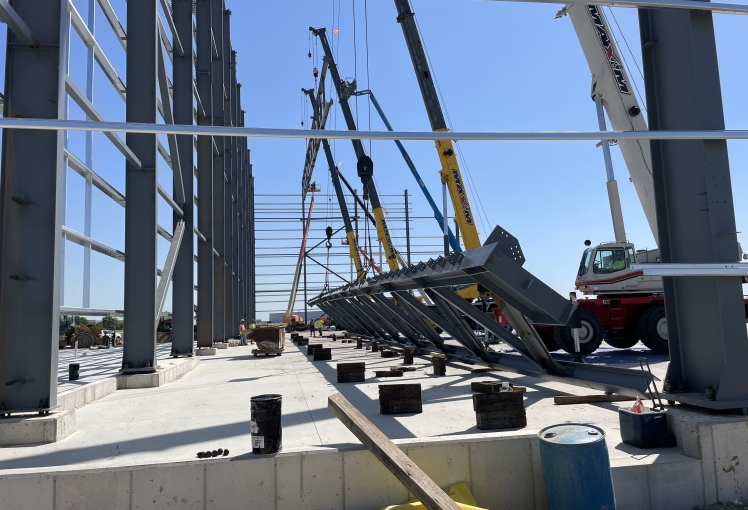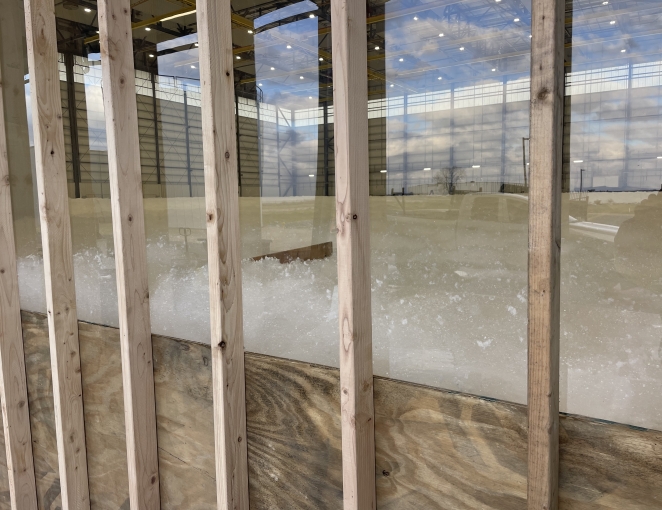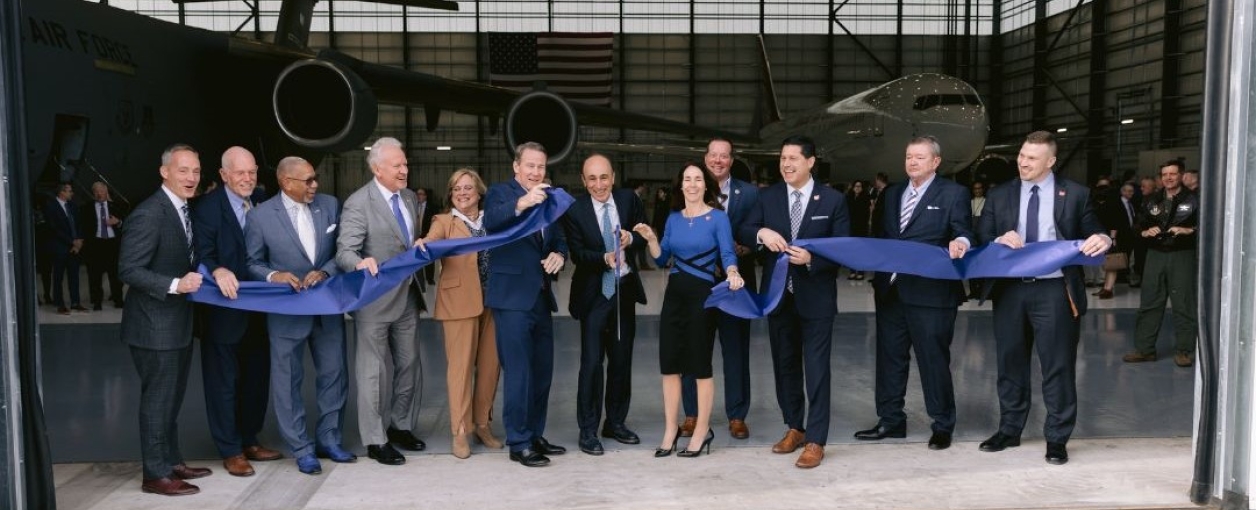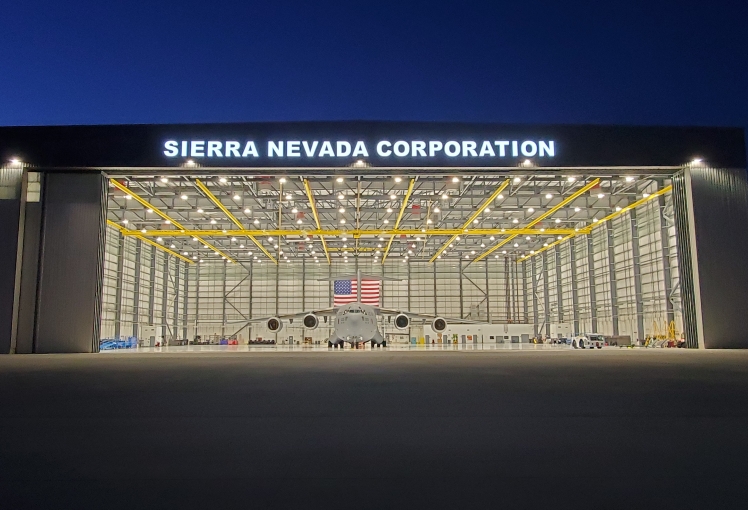
BUILDING A NEW 100,000 SF HANGAR
In 2021, Shook Construction participated in a state-wide effort, along with key partners such as Ohio Lt. Governor Jon Husted, JobsOhio, Dayton Development Coalition, Montgomery County, and the City of Dayton, to encourage Sierra Nevada Corporation (SNC) to build its new facilities in the Dayton region. SNC ultimately chose Dayton – the birthplace of aviation – for its proximity to the Wright-Patterson Air Force Base, the largest single-site employer in Ohio, and available land space. In February 2022, Shook broke ground on SNC’s new, 100,000-square-foot Aviation Innovation and Technology Center, located at the Dayton International Airport. This is the first large aircraft maintenance, repair and overhaul (MRO) facility constructed in the Dayton region since WWII and is capable of supporting some of the largest aviation projects in the world.
The new facility includes a 90,000 SF hangar, 7,600 SF of administrative space, 7.5-ton bridge crane and 3-ton tail crane, 325,000-gallon water tank, 14 foam generators, and three 3,000 GPM fire pumps. The project required significant technical planning and execution, as the facility stands 90 feet tall with a massive hangar clearance of 72 feet high by 255 feet wide. Ten trusses were set in place for the project, each weighing ~80 tons, requiring four 100-ton cranes per lift, and taking 12-14 hours to raise and secure the necessary structural bracing. After mobilizing in January 2022 and occupancy in November 2022, this notable CM at Risk project was completed in just eleven months.
Today, the state-of-the-art facility offers more than just a regional home for the aerospace and defense giant; it also brings 140 new jobs to Ohio and economic growth to reestablish Dayton as the nation’s aviation hub. After successfully building one of the largest private hangars in the nation, Shook will begin work on SNC’s Hangar #2.
CM AT RISK | $38.5M | 100,000 SF
“Shook truly is an incredible customer service eccentric contractor and is breaking the mold in the industry. They listen to understand their customer’s requirements and effectively not only meet but exceed expectations. Their team has very clear and consistent communication and genuinely cares about their customers, which is shown in the exceptional quality of their work. The time taken to foster a relationship with their customer allows for the team to anticipate needs of the client as well as work together to tackle any obstacle with effective solutions by providing the details necessary for the client to make an informed and best possible decision.” – Cynthia Sanchez, CRE PM, SNC

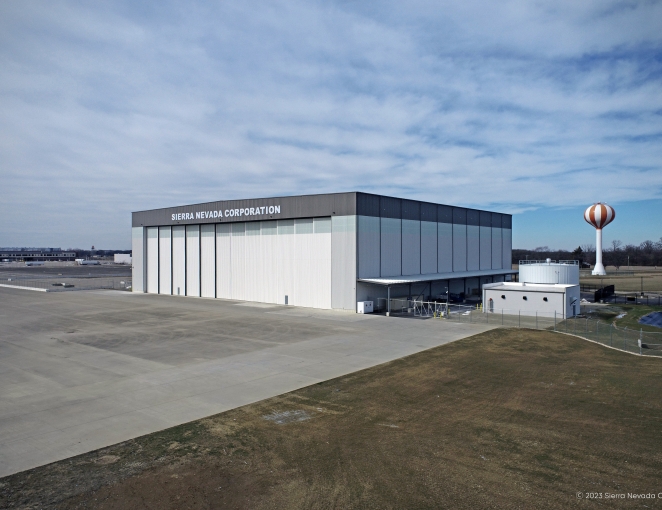
MEETING THE CHALLENGES OF A DIFFICULT JOB
The challenges of building the Sierra Nevada Corporation (SNC) Aviation Innovation and Technology Center were immense. Several unique situations encountered early in the project created an opportunity for collaborative problem-solving with a short time to find resolutions. The first two challenges included the relocation of both underground electric and gas utilities. These services were indicated in the existing record drawings as public utility lines to be relocated by the appropriate provider. Shortly after groundbreaking, our team discovered they were private lines required to be captured in the project. The electrical conflict was two 12,470-volt primary feeds to a local facility and the gas was an 8-inch medium-pressure line serving multiple buildings inside the airfield.
Shook worked closely with the landlord and tenant of the facility through the relocation of the medium voltage lines to ensure there was no impact to the facility/operations while performing the work. Additionally, we coordinated with Airport Security for access to the area as well as maintained all associated safety requirements. To accomplish the gas line relocation, three Hot Taps were installed to ensure no outages were experienced, as there were no complete record drawings verifying who would be affected if there was a shut-off.
Furthermore, the project site had questionable soils and significantly large footings – 60'x30'x3' at all four corners. The Geotechnical Report indicated that moderately-to-highly plastic soils, classified as lean clay (CL) and fat clay (CH), were encountered within the upper 5.5-feet at the central to western portion of the site. The report anticipated that a portion of the hangar’s spread foundations and slab-on-grade would bear near or on the moderately-to-highly plastic soils. These soils were susceptible to volume change with variations in moisture content. Should the volume changes occur within the building or paved areas, the resulting deformations could have caused undesirable cracking in the pavement or vertical movements of the foundations and floor slabs, forming cracks in masonry walls and floor slabs.
Due to the resulting report, Shook added an over-excavation of 1,200’ x 20’ with an average depth of 3’ 9” while maintaining the project schedule. The largest footers were a structural footer at 60’ x 30’ x 3’ and a hangar door footer at 300’ x 15’ x 4’ 9”.
Due to the location at the Dayton International Airport, our team worked through unique challenges specific to the airfield. For starters, TSA fencing was required to separate the airfield from the non-secured area. Resultingly, 2,512 feet of TSA-approved fence was installed prior to mobilization. Shook created a temporary fence plan that allowed the majority of construction to occur outside the secure zone. Furthermore, wind plays a factor in the airfield due to open space across the runway. This added complexities, as work to set the trusses, siding, roofing, and insulation of the building had to be scheduled around the weather. Early in the project, our team created a plan around the windspeed to prioritize safety. Ultimately, all cranes and lifts were required to be lowered if conditions became unsafe, which was dependent on both the load and windspeed.
Material availability also presented challenges. The 4-inch, 10-inch and 24-inch Ductile Iron Pipe (DIP) sizes could not be fabricated until October and wouldn’t show up until November – the project’s scheduled completion. The resolution was relatively simple but costly. Shook replaced the 10-inch DIP with 12-inch DIP of the same classification to keep the project on schedule. Additionally, we increased the class of the 4-inch and 24-inch DIP to materials that were in stock elsewhere and had them drop shipped to the site on dedicated trucks. At times, we bought from a contractor in other regions that had materials available and wouldn’t need them for some time. As such, DIP began in March and was completed by September.
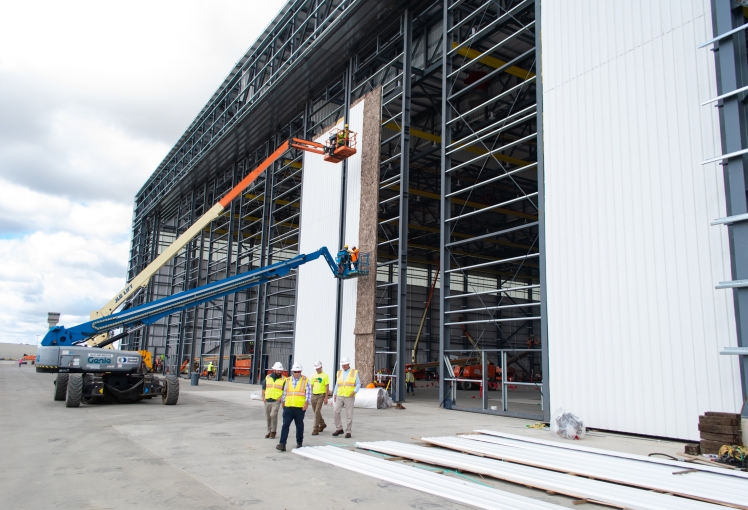
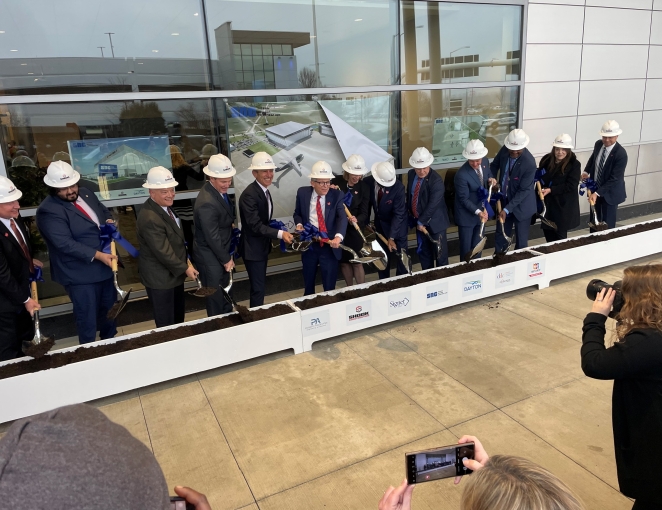
EXCELLENCE IN CLIENT SERVICE
Shook participated in a state-wide effort, along with Ohio Lt. Governor Jon Husted, JobsOhio and the Dayton Development Coalition (DDC), to encourage SNC to build its new facilities in Dayton. Though SNC was the tenant, the developer was Signet Real Estate Group (Signet). Our team worked with both SNC/Signet in the early stages, including touring them around the Dayton International Airport and potential project site to secure the project in Ohio.
The preconstruction effort offered an early opportunity to demonstrate excellence in client service. Shook spent over a year working with the owner/design team to determine the correct budget based on the specified minimum spatial requirements as well as fit, finish, and equipment desired for a functional space. The process involved two trips to SNC’s headquarters in Denver, as well as two existing non-SNC sites with similar requirements. The efforts were well served; once the final GMP was established, the contingencies were reduced to a minimum and were able to capture the unknown and/or unforeseen obstacles that arose. The project was awarded at $38,471,189, including 3% in contingencies. Shook closed out the project with a deduct change order to remove the remaining contingencies for 1% of the overall project budget or one-third of the contingencies from award.
Uncommon to many of our construction projects, neither SNC/Signet were located locally, and key personnel were spread across Texas, Colorado and Florida. Aside from one monthly site visit, communication with the team was fully remote. Shook provided detailed weekly reports including construction activities completed, outstanding items/issues, two-week lookaheads, and progress pictures. Both SNC/Signet noted how helpful these reports were to stay informed and update internal stakeholders.
Shook performed additional tasks to best serve our out-of-state clients, such as obtaining field measurements between concrete piers to plan furniture layout and comparing samples to hangar siding colors to select finish colors, preventing a delay in mailing samples. Per request, Shook compiled a list of all finishes with manufacturer, models, and colors, as well as a drawing showing floor finish locations, to be used on SNC’s future projects around the nation. By establishing early on that our team was accessible, we received many texts/phone calls to quickly answer questions about hardware, finishes, outlet locations, and more to relay to SNC’s IT team, Security, or furniture vendors while in meetings.
Shook was an extension of SNC’s team in every respect; so much so, that during the hangar project, they asked for assistance with another project: renovating their local headquarters in Beavercreek. More recently, Shook was selected to build SNC’s second hangar in Dayton. Our continuation of work for SNC reflects the relationship/trust built.
“Very professional, effective management team, great communications and delivered an exceptional product. Being on-site the last three months of the project, I was able to witness these attributes. When problems arose, the team gathered quickly, discussed the issues and probable outcomes. Nothing was too hard to resolve in a timely manner. I have been involved with several projects similar to this one and this by far is the best construction team I have worked with.” – Gary Morgan, VP Ops, SNC
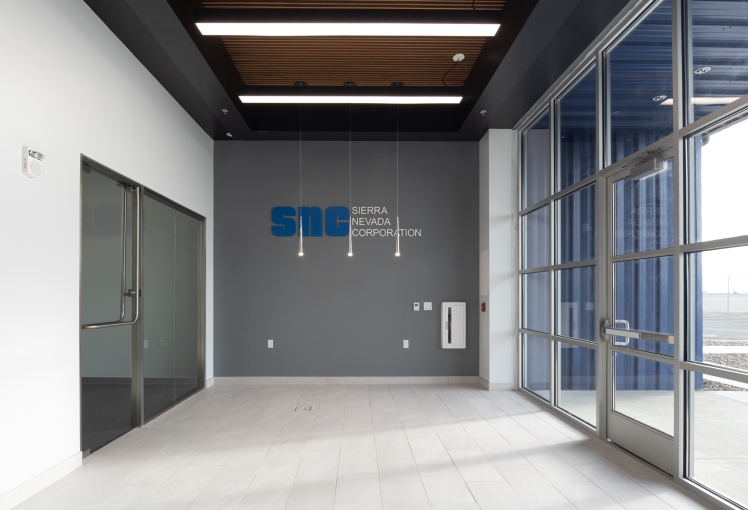
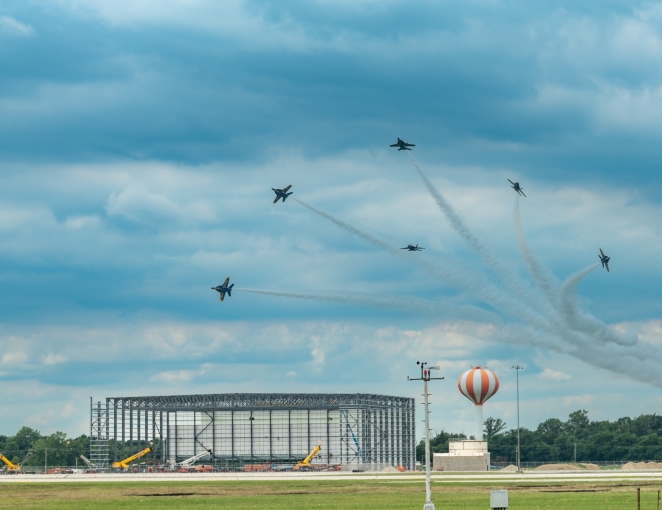
EXCELLENCE IN PROJECT MANAGEMENT
The stakes were high on executing this project flawlessly, as entities such as Lt. Governor Husted, JobsOhio, and DDC had worked tirelessly to secure this project in Ohio and the success of it was instrumental to SNC building future projects in the state. Shook’s leadership leveraged our relationship with Passero Associates, a trusted A/E partner, and 37 subcontractors to build a strong CM at Risk team.
Being brought on early in the design process allowed for several advantages. The Pre-Engineered Metal Building (PEMB) was released five months prior to the Architectural / MEPS design completion in order to achieve the turnover date needed. Additionally, the critical path was established early in the project with the interim milestones being PEMB release, building pad complete and stabilized, foundations and slab on grade complete and cured prior to the pre-engineered metal building arrival and erection, building dry-in, inspections, and occupancy testing.
An aggressive 11-month schedule was established for the project. Challenges such as soil conditions, material availability and unanticipated utility relocations arose, but strict management of the schedule by our team allowed for adjustments to be made while keeping on pace.
Additionally, due to the Dayton Airshow and the project’s proximity to the airfield, Shook was unable to perform aerial work and had to restrict access to the site for four days. This event occurred at a critical time when our team was raising 300-foot trusses that required four cranes to lift, so the aerial restrictions significantly impacted the work. Our team taped off access zones for the client, coordinated with the Dayton International Airport, and planned the work around the FAA restrictions to continue progress during those days. Shook was able to keep the building erectors working on siding the north side of the building during this time, as they were able to stay below the height restriction, and other trades inside the north half of the building outside of the flight zone.
A challenge encountered after the superstructure was complete was managing the number of manlifts that were required by each trade to complete their work at the roof truss level. To meet the aggressive schedule, Shook needed all trades working in ~20 articulating boom lifts, each extending 80-100 feet, across the 90,000-square-foot area. Shook implemented two critical safety precautions so the lifts could move around as needed: barricades were placed around every lift and under the working surface of the basket, and spotters were required on the slab to keep people safe around moving lifts. While all of this was ongoing, the epoxy floor surface had to be completed. The epoxy process was divided into six sections to allow the other trades to continue working overhead and along the walls. Our project management team’s planning and immense coordination effort ensured lifts and material were placed where they were needed prior to epoxy being started.
Excellence in project management and overseeing a robust team of 37 subcontractors was pertinent to deliver the schedule on time. Crews ranged from 80-100 workers during the week and 30-40 on the weekends with good weather, topping out at 110 workers. Crews were on-site seven days a week from 6:00 a.m. to 8:00 p.m. from January through November to accomplish the schedule. Considerable time was spent pre-planning the work and our team executed the plan safely and efficiently. Working 11 months and yielding approximately 120,000+ manhours, Shook and our trade partners had zero lost time injuries. Shook’s Kenny Bowshier received an Outstanding Craftsmanship Award from the Coalition for Construction Safety for his efforts on the project, a testament to Shook’s prioritization of safety throughout construction.
By planning the work, monitoring and adjusting manpower and leveraging our relationships with subcontractors/suppliers, Shook was able to deliver the project two weeks early.
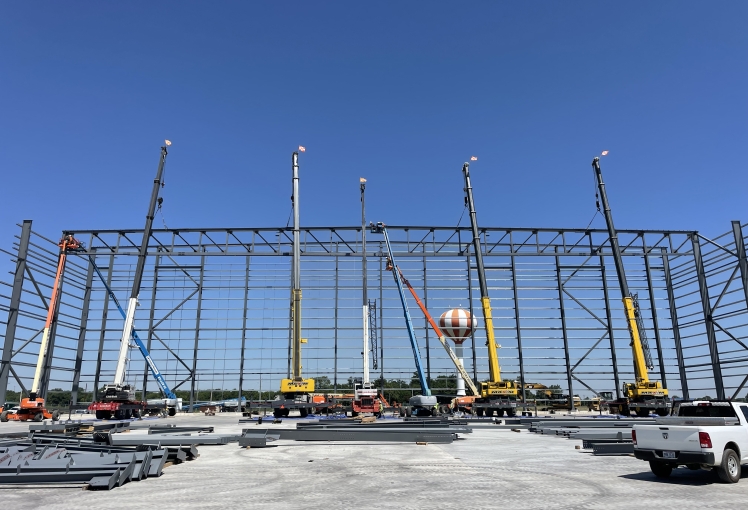
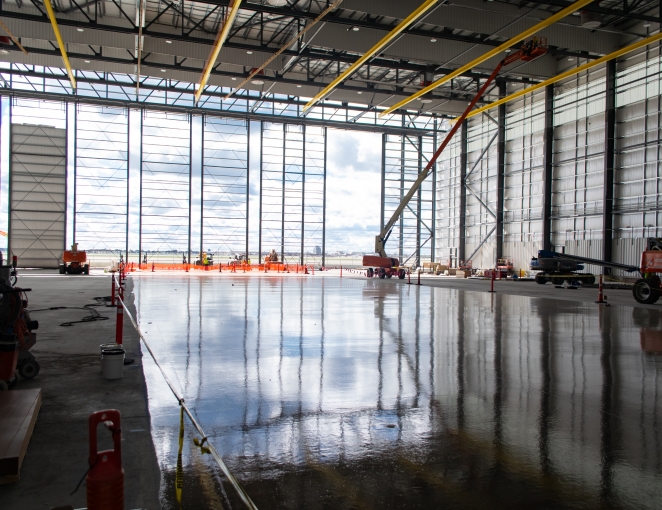
INNOVATIONS IN CONSTRUCTION TECHNIQUES / MATERIALS
Due to the facility's grandeur size, material delivery delays and fire protection requirements, the project required innovation in both techniques and materials. The facility stands 90 feet tall with a massive hangar clearance of 72’ x 255’. To achieve this, the 90,000-square-foot hangar included ten, 300-foot free-span trusses. Each steel truss weighed a massive 77.6 Tons. The trusses were assembled into two sections on the ground and each section was hoisted 90 feet into the air by two, 100-ton cranes simultaneously. The first truss took six days to sort out the steel members, assemble, and plan for the lift. After a few trusses were erected, the ironworkers cut the assembly time down to 2-3 days, helping to accomplish the tight schedule.
Weeks before the steel arrived, meetings were held with Shook’s construction management team, safety team, and the building erector to review the critical lift plan. The plan specified the sizes of cranes needed, load of picks, and exact locations to be positioned. On days of a truss pick, as well as any day steel was set, all cranes/boom lifts were thoroughly inspected, morning pre-task plans were reviewed with trades involved, and remaining trades were notified the area was off-limits.
In total, a truss lift required four, 100-ton cranes. The erectors first tied both ends of the truss sections into the columns before bolting the two sections together. They then added the horizontal members between the newly erected truss and the previous one. It took ~10 hours before all four cranes could come off the truss and another two hours before all steel/hardware were installed. Altogether, our team erected 1,186 Tons of primary steel in just eight weeks, an enormous accomplishment.
One unique aspect of this project was the foam fire suppression system, often used in aircraft hangars to smother large jet fuel-fed fires. Many components of the system must be triggered if a fire alarm is pulled or smoke is detected. When activated, three 460 HP fire water pumps pull water from a 325,000-gallon water tank to feed the suppression system. A high-expansion foam solution is mixed with the water inside the hangar, traveling to 14 foam generators to mix the solution/water to create foam. Concurrently, a diversion valve opens to a storage lagoon to hold the water/foam upon leaving the hangar, preventing it from entering the sewer system.
To pass inspection, Shook had to run a foam test to prove to the city building inspectors, Fire Marshall, EPA, and our clients that the system worked as designed. All fire alarms, fire water pumps, foam system, and diversion valves would be tested to ensure everything was in sync. This was the final inspection before a temporary certificate of occupancy (TCO) could be awarded. Due to the infrequent occurrence of foam suppression tests and the need for several inspectors, the test was planned 2+ months in advance and there were no exceptions to pushing the date.
However, the fire pumps became critical path as the project neared completion. They were scheduled to be delivered August 1 but arrived November 7, just eight days before the scheduled foam test and a few weeks from contract completion. This resulted in the three 600 HP, 3,000 GPM diesel-powered pumps and all associated piping/control needing to be completed in a matter of days to allow for pre-testing and acceptance testing to occur. When the fire pumps arrived, the fire suppression team and electricians worked double shifts until all components of the system were pretested and functional. Resultingly, the foam test occurred as scheduled, with six feet of foam covering the floor in three minutes. Though it was a push to the finish, Shook successfully passed the inspection, received the TCO, and finished the project two weeks ahead of schedule.
